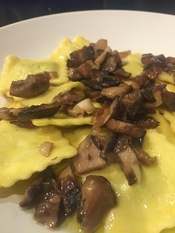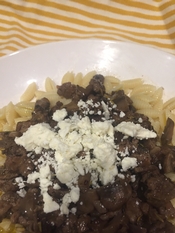As the days of Coronavirus stretched into weeks and now months, some of my friends and colleagues report that their relationship to cooking and eating hasn’t changed much during the pandemic. My friend Yola, for example, who is one of the best home cooks I know, says, “I still cook real meals from real recipes in real books.” By contrast, other friends tell me that they have been focusing mostly on simple fare such as sandwiches and canned soups. Other people (I don’t know any of these myself…but I’ve read about them) are apparently teaching themselves how to make fancy pastries or have ventured into advanced bread baking. As for me, I’ve developed a fixation on mushrooms.
At this particular moment in history, when many of us are looking for foods that are nutritious, versatile, have a relatively long shelf life, are easy to prepare and don’t take up much room on the fridge, friendly fungi can play more than just an attractive supporting role in our menus. I’ve long loved mushrooms for their fine flavors and textures and for the many different varieties available. As an added bonus, one thing I’ve learned in the past few weeks is that when mushrooms play a bigger role in the meal they can pair beautifully with wine. But more about this in a minute.
Since I have no desire to go grubbing around in the woods for wild fungi myself, I purchase mine from the farmers market or, these days, the supermarket as our farmers market has not yet reopened. In the past I tended to pass up the simple white, or button mushrooms in favor of more exotic shitake, morel, oyster, enoki and so on. But then, a few weeks ago, my  market’s mushroom supply temporarily dwindled to almost nothing except boxes of sliced white mushrooms and a handful of tired shitakes. I grabbed two boxes of the sliced mushrooms and was so pleased with the results that I’ve been adding them to my cart on subsequent shopping expeditions along with other varieties as they became available again. The small button white and crimini mushrooms, all the way through the large, brownish portabellos are actually just different aged versions of the same mushroom (Agaricus bisporus). Even these simple and relatively inexpensive mushrooms can be a valuable addition to a menu in terms of taste and nutrition. They are essentially fat-free and low in calories (a cup of raw mushrooms contains about 44 calories). Mushrooms are surprisingly high in protein and are also one of the non-animal sources of vitamin D as well as vitamin B12. All types of edible mushrooms contain varying degrees of protein and fiber as well as selenium, a powerful antioxidant that helps support the immune system and prevent damage to cells and tissues.
market’s mushroom supply temporarily dwindled to almost nothing except boxes of sliced white mushrooms and a handful of tired shitakes. I grabbed two boxes of the sliced mushrooms and was so pleased with the results that I’ve been adding them to my cart on subsequent shopping expeditions along with other varieties as they became available again. The small button white and crimini mushrooms, all the way through the large, brownish portabellos are actually just different aged versions of the same mushroom (Agaricus bisporus). Even these simple and relatively inexpensive mushrooms can be a valuable addition to a menu in terms of taste and nutrition. They are essentially fat-free and low in calories (a cup of raw mushrooms contains about 44 calories). Mushrooms are surprisingly high in protein and are also one of the non-animal sources of vitamin D as well as vitamin B12. All types of edible mushrooms contain varying degrees of protein and fiber as well as selenium, a powerful antioxidant that helps support the immune system and prevent damage to cells and tissues.
 market’s mushroom supply temporarily dwindled to almost nothing except boxes of sliced white mushrooms and a handful of tired shitakes. I grabbed two boxes of the sliced mushrooms and was so pleased with the results that I’ve been adding them to my cart on subsequent shopping expeditions along with other varieties as they became available again. The small button white and crimini mushrooms, all the way through the large, brownish portabellos are actually just different aged versions of the same mushroom (Agaricus bisporus). Even these simple and relatively inexpensive mushrooms can be a valuable addition to a menu in terms of taste and nutrition. They are essentially fat-free and low in calories (a cup of raw mushrooms contains about 44 calories). Mushrooms are surprisingly high in protein and are also one of the non-animal sources of vitamin D as well as vitamin B12. All types of edible mushrooms contain varying degrees of protein and fiber as well as selenium, a powerful antioxidant that helps support the immune system and prevent damage to cells and tissues.
market’s mushroom supply temporarily dwindled to almost nothing except boxes of sliced white mushrooms and a handful of tired shitakes. I grabbed two boxes of the sliced mushrooms and was so pleased with the results that I’ve been adding them to my cart on subsequent shopping expeditions along with other varieties as they became available again. The small button white and crimini mushrooms, all the way through the large, brownish portabellos are actually just different aged versions of the same mushroom (Agaricus bisporus). Even these simple and relatively inexpensive mushrooms can be a valuable addition to a menu in terms of taste and nutrition. They are essentially fat-free and low in calories (a cup of raw mushrooms contains about 44 calories). Mushrooms are surprisingly high in protein and are also one of the non-animal sources of vitamin D as well as vitamin B12. All types of edible mushrooms contain varying degrees of protein and fiber as well as selenium, a powerful antioxidant that helps support the immune system and prevent damage to cells and tissues. One of the first things I cooked starting in late February as the first hints of the pandemic began circulating, was mushroom soup, and I am still turning out variations of that soup today. Nothing could be simpler than the basic sautéing together in a little olive oil of sliced or chopped mushrooms, onions or shallots, garlic (lots of it), and maybe some sliced carrots and/or a variety of fresh herbs (I’ve discovered that I am particularly fond of the flavors of cilantro and mushrooms mingling together). I also like to add some zip to the soup with soy sauce and/or fish sauce, plus maybe a little ginger and perhaps a jolt of Sriracha or Aleppo pepper. After simmering in chicken or vegetable broth for 20-30 minutes it all gets whizzed in a blender or sometimes just coarsely mashed.
I’ve stored several batches of this soup in plastic freezer bags, which are easy to pack flat in the freezer (after transferring the mixture into a pot for reheating I rinse out the freezer bag with a little more stock or some cream which I add to the soup). A heady white wine is usually a good accompaniment to these soups, although sometimes I’m more in the mood for an earthy Pinot Noir. (Mushrooms and Pinot Noir are, traditionally and gastronomically speaking, like Calvin and Hobbes, or Fred Astaire and Ginger Rogers. Well, you know what I mean: partners who bring out the best in each other).
Duxelles is a traditional French preparation of finely minced mushrooms cooked in butter along with onions or shallots, garlic, and perhaps a little minced parsley, and salt and pepper. Cream is sometimes added to the mix, and maybe even a glug of sherry. Button mushrooms are traditional, though I’m not sure it makes much difference what kind of mushrooms are in Duxelles. If you are one of those people who are ramping up your cooking repertoire these days you may be glad to know that Duxelles plays an important role in Beef Wellington, that extravagant French classic dish in which a beef tenderloin is coated with foie gras and then Duxelles; the ensemble is then wrapped in puff pastry and baked. If this is a more extravagant an undertaking than you had in mind you might consider simply spreading Duxelles on some nice bread, crostini or toast points and pouring a glass of Champagne to enjoy with this deliciously festive little snack. Duxelles also makes a fine filling for omelettes or topping for pasta. By the  way, the reason the word Duxelles is traditionally capitalized is in reference to the Marquis d’Uxelles, a significant 17th and 18th French diplomat and, let’s assume, mushroom lover.
way, the reason the word Duxelles is traditionally capitalized is in reference to the Marquis d’Uxelles, a significant 17th and 18th French diplomat and, let’s assume, mushroom lover.
 way, the reason the word Duxelles is traditionally capitalized is in reference to the Marquis d’Uxelles, a significant 17th and 18th French diplomat and, let’s assume, mushroom lover.
way, the reason the word Duxelles is traditionally capitalized is in reference to the Marquis d’Uxelles, a significant 17th and 18th French diplomat and, let’s assume, mushroom lover. While a meaty co-star is not essential to the enjoyment of mushrooms it’s fair to say that mushrooms make good partners for meat, whether chicken, beef or pork. Hankering recently for a taste of lamb I sautéed together some onion, sliced mushrooms and garlic with about 8 ounces of ground lamb, all generously seasoned with salt, pepper, red pepper flakes, some rosemary and thyme, and of course a splash of red wine. I spooned the final mixture over cavatelli drizzled with olive oil (other smallish pasta such as fusilli, rotini, gemelli or orzo would also work well). Topped with feta cheese this was a delicious meal indeed and a perfect companion for the two California/Sonoma Valley wines I poured with it: Dry Creek Vineyard “Heritage Vines” 2017 Zinfandel, a lovely and well balanced Zin with flavors of dark fruit that seemed to embrace both mushrooms and lamb, and Pedroncelli “Signature Selection” Russian River Valley 2017 Pinot Noir, a relatively light Pinot whose smooth tannins and refreshing finish proved an elegant accompaniment to the dish.
More columns by Marguerite at Marguerite Thomas.
Connect with her on Twitter at @M_L_Thomas
